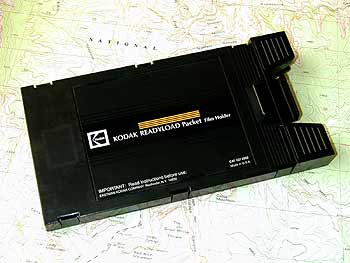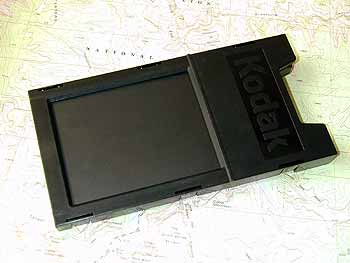Readyload and Quickload Film and Holders
Fujichrome Quickloads – I gave up traditional sheet film shortly after Kodak came out with the Readyload film packets back in the early 1990s. For me, the complete absence of dust on the film was more than worth the extra cost for these films.
Fujichrome Quickload Film
The color film I used most was Fujichrome Provia (RDP III). I found it the best all-around transparency film available for my style of photography. Occasionally I used Fujichrome Astia 100F (RAP 100F), Velvia 100 (RVP 100), Velvia 100F (RVP 100F), and even tungsten-balanced RTP II.
Kodak Readyload 4×5 Film Holder
The back of the Kodak Readyload film holder is shown above. The film slides into the holder from the right side. When fully inserted, it snaps into place, and the paper sleeve shielding the film from light can be carefully withdrawn until it reaches the stop. You did need to be careful not to pull the sleeve completely out of the holder; otherwise, the film would be ruined.
After exposure, the sleeve is slipped back down until it seats in the bottom of the Readyload packet. Then you press the tab on the holder’s right end to release the film, and you could finally remove it from the holder.
The Fujichome Quickload holder works in a very similar fashion to the Kodak holder. I did find that Fuji made the Quickload film and holder just different enough that Fuji film packets could be used in the Readyload holder, but they would sometimes jam in the Readyload holder. The Kodak packets worked well in the Quickload holder.
For black and white work, I used to use Kodak T-Max 100 Readyloads, but in 2005, I switched to Fuji Acros 100 Quickloads.
Fuji Quickload Film Holder – As I switched to all Fuji films with the availability of Fuji Acros 100 in the Quickload format, I finally bought a Quickload holder. A Kodak Readyload Film holder is carried in the car as a backup.


